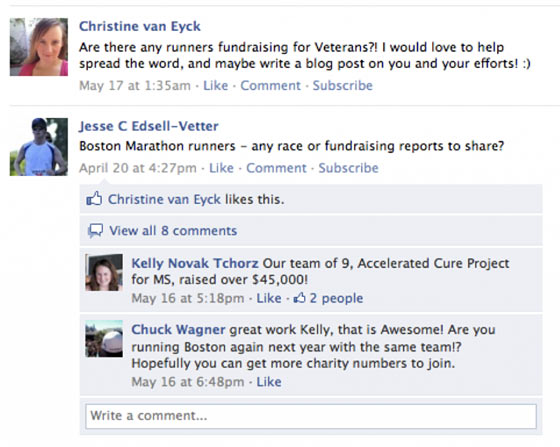
Remember Facebook Groups? A screenshot from the FirstGiving for Runners Group.
Groups is where real community engagement is happening
Target audience: Nonprofits, cause organizations, foundations, NGOs, social enterprises, businesses, educators, Facebook members.
Afriend recently asked me: “What are you excited about now in Facebook?” Without hesitation, I replied, “Facebook Groups.” Yes, Facebook Groups, not Pages. Written off and abandoned by almost every organization I knew once Pages beefed up its functionality three years ago, Groups is where the real community engagement is happening now.
I’ll admit that I, like so many consultants, advised clients to close their Groups and focus on Pages a few years ago. With good reason: Facebook came out with the Like button that tied Facebook Pages to websites and almost every Web interface. Facebook poured its time and promotion into Pages, making them even more robust with deep analytics, applications, and utility. There was no “join” button offered to join a Facebook Group, only a poorly adopted “send” button.
In late 2010, Facebook revamped Groups entirely and they began to take off. The “new” Group features include notifications of group actions and activities, document uploading, group chat, threaded commenting, inbox messaging about group events, and mass messaging to inboxes (described in more detail here). This was when everyone I knew began to explore Groups once again.
Why am I so excited of late about Facebook Groups? Why now?
The answer lies in what I’ve begun to realize that Facebook Pages cannot offer: real community and deep engagement.
Lately I’ve begun advising clients to consider creating (or adding back) a Facebook Group, in addition to its Facebook Page. While I have consistently counseled that Page owners must use Facebook Pages to create community and deepen commitment with stakeholders, that trust and commitment can never compare to what happens in a Group. From the Page cover photo intended to tell the message, to the Page Timeline intended to tell the story, to the Page updates intended to encourage conversation, there is opportunity for real conversation on a Page.
But it just isn’t happening. I don’t see Pages becoming a real organizational community anytime soon.
Pages are designed to be a one-way relationship
The Facebook Page concept is for it to be the company space on Facebook, which usually includes company branding and messaging. While there’s nothing wrong with this, the very act of creating a “company space” means that it is not a “community space.” I have yet to see an organizational Facebook Page that is wholly devoted to and encouraging of fan updates, fan news, or driven by fans. (I think this could be a fascinating experiment in organizational community-building, however!) Even Facebook Pages that are fully devoted to its fans tend to broadcast organizational news and updates more than not. Waiting for fans to post may mean waiting a long, long time.
In addiiton, Pages are at the mercy of the Facebook news feed algorithm. Posting an update to a Page doesn’t mean fans will see it. The average post by a brand only reaches 16-17% of fans. If that update is shared, commented upon, and Liked by more than a few, then Facebook will optimize that post to show more prominently in certain fans’ news feeds. One of the reasons Pages struggle so much with engagement: Most people don’t see the updates. Compounding this, most fans don’t visit the page once they’ve Liked it.
The real community on Facebook: Facebook Groups
Groups, on the other hand, are designed to facilitate online community-building. The mere fact that administrators must post as people changes the internal dynamic of the group conversation. It becomes more personal. Group members are notified when anyone posts, as opposed to relying on it appearing in a news feed. The conversation tends to focus on issues, experiences, and connections.
I am a member of several Facebook Groups created by organizations in order to launch and discuss either an online campaign or an issue. Within these, I’ve seen friendships build, investment in the group and organization deepen, and member-to-member connections move people to action. There’s a bit of magic that happens when a group begins to feel and act like a connected community. I’ve witnessed great, even “magical” ideas generated from within the group. The organization is just the facilitator, and the momentum is generated from within the members of the group.
When I was the community manager at FirstGiving, I opened up a FirstGiving for Runners Facebook Group. There were a lot of people raising money for causes by racing, and I felt that there would be a natural communal affinity amongst runners. Instantly things were different within the Group than on FirstGiving’s Facebook Page: the conversation was never about what FirstGiving was doing, because no one wanted to talk about that. The conversation was about training, running, raising money, causes people cared deeply about.
In no time at all, it became a true community: people friended each other, donated to each others’ fundraising pages, encouraged each other professionally and personally. We asked the active members of this group to join FirstGiving as guest bloggers and online cheerleaders, and they happily did. It was not only a community, but strengthened the connection between FirstGiving and its stakeholders.
Aren’t organizations about connecting people to an issue? The connector between the people and the organization is the community.
I’m looking forward to seeing more organizations building community with Facebook Groups. If you are already doing so, I’d love to hear about it in the comments.
 This work is licensed under a Creative Commons Attribution-NonCommercial 3.0 Unported.
This work is licensed under a Creative Commons Attribution-NonCommercial 3.0 Unported.








